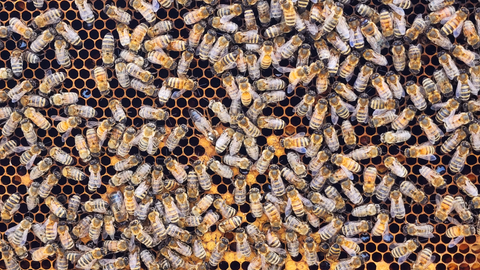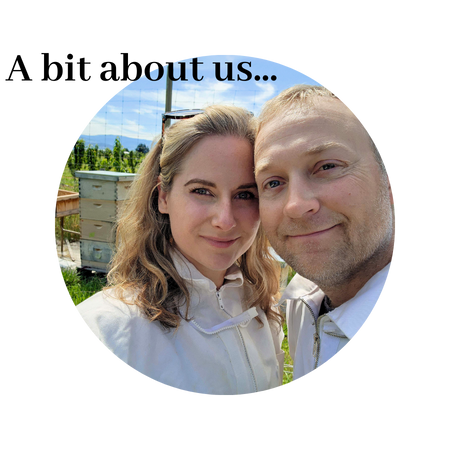In a bee colony, there are several castes. These include the Queen bee, the drone bee and the worker bee. Each caste has a very special and specific job, and we are going to explore the job description of the queen bee.
The Queen bee. Everyone has likely heard this term, but what exactly is a queen bee? In regards to honey bees, the Queen is the one bee who rules the hive. But she is so much more than that.
Here, we are going to talk about who the Queen bee is, what her role is in the hive and what makes her so special.

Honey Bees | What Is A Queen Bee?
We are going to cover several points in this article about Queen bees, including:
- How a Queen bee is created
- When does a Queen actually become a Queen
- What a Queen bee is
- What is the job
- How to identify a Queen honey bee
How A Queen Bee Is Made
How is a Queen honey bee created?
When naturally created by the hive, a Queen honey bee is fed royal jelly as a larva, and then emerges from her cell in 16 days.
Here is a photo from our own backyard hives when we discovered multiple Queen cells being created. You can see the royal jelly both in the cell surrounding the Queen larva in her Queen cell and then on our hive tool in the next photo:

Once emerged, the Queen immediately gets rid of her undeveloped sister queens in their cells before they emerge so she is the only Queen in the hive.
You see, when bees need a new Queen, they make several potential Queens by creating and feeding multiple Queen cells with royal bee jelly.
This is why the first Queen who emerges, reigns, as she gets rid of the others whom have not yet emerged.
When Does A Queen Become A Queen?
The majestic Queen of the hive starts her ruling as soon as she is born and she is a new Queen. Her physical body characteristics and even her internal organs are different than the drone bees or worker bees.
She is special right from the larva stage, so she is literally born a Queen and will be the only one who can lay eggs to create more new bees.
The Queen & Mating
The Queen won't be able to lay fertilized eggs until the Queen mates, and to do this, the virgin Queen will go on what's called a "mating flight" and find a drone from another colony, as they are the only males.
Once the Queen mates successfully though, she won't have to ever mate again. The Queen bee starts to lay her fertilized eggs (or she can choose to not fertilize them to produce drones bees) to grow her colony.
What A Queen Honey Bee Is
What is a Queen bee? A Queen is a female bee that has been fed a special food called royal jelly while she was a larva. This causes her ovaries to develop as she will be the only bee in the hive able to lay eggs.
The Queen bee's job is the most important in keeping a honey bee hive going. She releases pheromones that the worker bees and drone bees come to know and recognize her by. The Queen bee's life long focus is to lay many, many eggs and make new bees for her colony.
The Queen is fed by the worker bees and cleaned by the workers, and is completely taken care of by her colony so she only has to focus on her job of egg-laying.
All worker bees do her bidding but her life isn't what some may think. If the Queen bee shows any sign of weakness, her offspring will raise a new Queen by creating new Queen bee cells and feeding them royal special jelly.
The Queen Bee's Job
There is only one Queen per honey bee colony (although in some cases, there can be unusual exceptions). As we previously said, the Queen is fed royal bee jelly at the larva stage during her bee development.
Once she is fed this, she is a Queen larvae and will continue to be fed this jelly to aid in her royal development.
When she emerges from her cell and has completed multiple mating flights, she settles into her colony and may not leave for years.
Here is a Queen cell from one of our hives:

The Queen releases pheromones that inhibit the worker bees (also females) from developing their ovaries. This is where the Queen bee's job becomes very important.
The job of the Queen is to lay her eggs
A honey bee Queen can lay around 2000 eggs a day. That's a busy day for her. Because we call her the Queen, that may lead you to think she controls the colony. The reality is more complicated though.
Studies have shown that the Queen may not even decide where to lay her eggs. Instead, she is herded by the worker bees to find their egg-ready cells.
Some bee keepers even refer to the Queen as the slave of the colony as she must continually lay her eggs and keep the hive it populated with constant new bees, otherwise, she will be gone.
The Queen is so focused on laying eggs that she doesn't even feed herself. The worker bees take care of that.
As nurse bees (worker bees) pass by the queen, they can be seen feeding and caring for her. This is to ensure she is in top condition for her egg-laying mission.
Queen bees are the longest living honey bee in the colony and usually live to 3 years old if healthy and strong. During this time, a queen can start new colonies by swarming.
How To Identify a Queen Bee
There are several physical characteristics you can look for when trying to identify the queen bee:
- The Queen is the largest bee in the colony measuring around double the size of a worker bee
- One feature of a Queen that stands out is her bald (and usually black) thorax. Breeders frequently paint the Queen's thorax with the international queen-marking color that repeats itself every 6 years since queens don't live that long. These Queen marking colors are white for years ending in 1 or 6, yellow for years ending in 2 or 7, red for years ending in 3 or 8, green for years 4 or 9 and blue for 5 or 0.
- The Queen has more fat stored in her body then worker bees. Because of this, as seen in sick and dying colonies, the queen can frequently be found as the last living bee.
Here is a photo of a frame of bees from one of our hives.
The Queen is in there, can you spot her?
Use the information above to see if any bee stands out to you:

Were you able to spot the Queen?
Here are some clues:
- She has a marking on her back, but it was wearing off a bit at this point. The marking was white and you can still see it.
- Her body is longer than the other bees on the frame.
- She is close to the center of the photo.
Give up?
Here is another photo of the same frame, but a bit more close up. We circled her in red:

It is important for a beekeeper to be able to spot the Queen quickly on a frame so he knows if she is still around, if if he/she just saved a swarm. A hive without a Queen won't last very long.
Whenever the beekeeper is doing an inspection, he or she always looks out for that Queen Bee.
Queen Bee Summary
In this article, you learned:- Queen bees are made into queens be being fed royal bee jelly in the larvae stage.
- There can only be one Queen in a honey bee colony
- When the Queen emerges, she kills off any other Queen cells to ensure she is the only queen
- The Queen goes on one mating flight once she emerges from her cell
- The Queen bee's only job is to lay eggs
- The Queen is fed and cleaned by worker bees so she can concentrate on laying eggs
- The Queen is the largest bee and can also be identified by her black thorax
- If healthy and strong, the Queen honey bee can live up to three years
We hope you learned all about the Queen and her role in the honey bee hive.
Be sure to bookmark this page! We'd love to see you here again!
Here are some other articles you may be interested in reading:
Everything Needed To Start BEEKEEPING
Where To Buy Beeswax Directly From Reputable Beekeepers
How To Make Beeswax Wraps | INSTRUCTIONS
Did you like this article?
❤️ Here's how you can support our blog:
My name is Linnea and I am a backyard gardening enthusiast! Along with my husband and our two kids (and chickens, ducks and our little dog Izzy). Our hobby - growing our own food and making our meals from scratch. My blog, The Farmers Cupboard, is the website that blossomed from that passion. I love every second I spend sharing our hobby with like minded backyard growers.
It's easy to support my blog, and it is so appreciated. Please SHARE an article somewhere, pin a photo to your Pinterest board, follow on any of our social medias or sign up for our newsletter! That's it!
These little things help our blog grow and allow us to continue doing what we love: growing good food and sharing what we learn.
PINTEREST PASSIONATE? We're opening up our cupboard to you!
Click on the pin below made just for you. It will bring you right to my little Pinterest community, where I would love for you to FOLLOW The Farmers Cupboard and see all of our gardening and backyard dream ideas!
Let's grow good things together!












0 comments